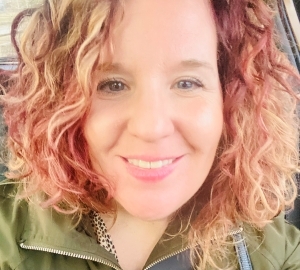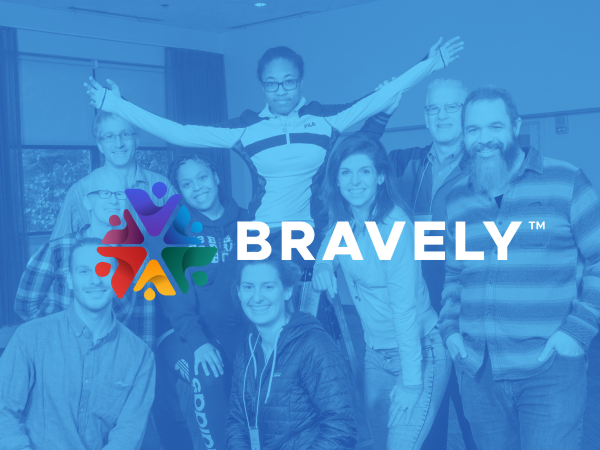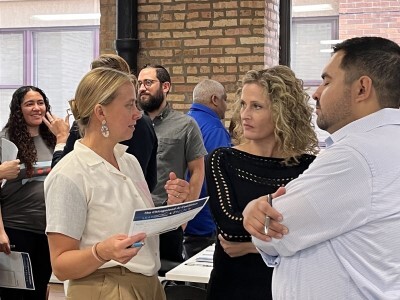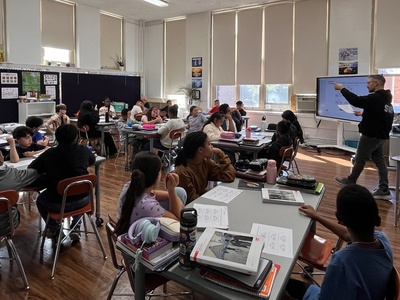Professional Learning
Transforming Classroom Structures to Increase Student Engagement: A Coach’s Journey toward Modern Classrooms
Topics
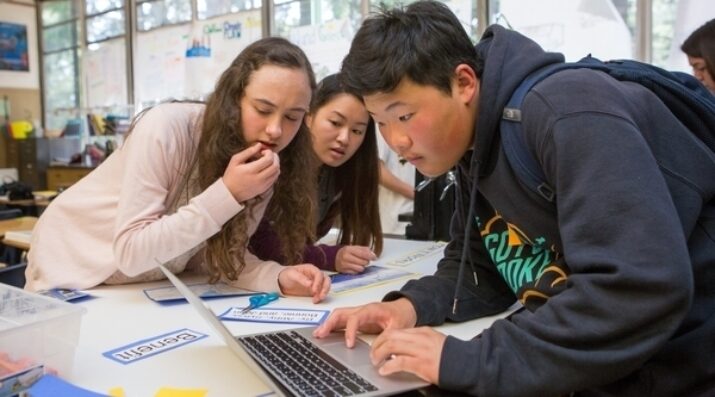
Educators are the lead learners in schools. If they are to enable powerful, authentic, deep learning among their students, they need to live that kind of learning and professional culture themselves. When everyone is part of that experiential through-line, that’s when next generation learning thrives.
Recognizing student engagement was a common struggle, a coach and two teachers shifted their practice from traditional and passive instruction to modern and active learning.
In January 2020, before the word asynchronous was common, two of my most talented middle school teachers told me, quite plainly, that they were done. The craft they once loved, teaching, was overshadowed by daily frustrations, school-wide concerns, and institutional pressures. As their teaching and learning coach, I knew a drastic change was needed to revolutionize their classrooms, and I knew I needed to be the leader who led the charge.
Some years later (and despite COVID), through modeling self-paced structures, real-world skills, and project-based learning, these two teachers are still in the classroom, acting as teacher leaders in the division and beyond, and transforming classrooms from traditional and passive to modern and active. They can never go back to the way things once were and are working to help other teachers feel the successes of a modern classroom. Here’s how we made it happen.
Step 1: Concerns, Commonalities, and Impacts
Our journey started with honest dialogue; the two teachers shared their concerns related to teaching and learning. Their list contained many, and each seemed critical. They looked to me for answers and a reason to continue. I knew that I needed to shift their focus from individual concerns to overarching themes because it would be overwhelming and unsuccessful to work at fixing multiple minor concerns. However, targeting a few more significant issues would be manageable. With a more targeted lens, we could develop strategies that were applicable to many roadblocks rather than smaller solutions that seemed like “just another thing.” To do this, I coached the teachers through an activity I now call concerns, commonalities, and impacts.
After creating an exhaustive list of concerns, we determined commonalities between them. Looking at commonalities opened the floor for impactful dialogues, leading us to conclude that most of our problems connected to a theme of student engagement. Students were simply not as engaged as they could or should be. This broadening of perspective lessened the teachers’ burden and opened their hearts and minds to the possibility of making things better. If we could get students more engaged, we’d solve many problems in the process.
We shifted our lens from concerns to solutions with student engagement in mind by asking how a lack of student engagement negatively impacts teaching and learning. The answer was clear—student achievement was declining, student self-efficacy was dwindling, and teachers were unhappy. As a teaching and learning coach, I knew the solution was to lead my teachers through a significant pedagogical shift—a self-paced classroom.
Changing whole-group instruction and teacher-driven conversations to individualized instruction and student-centered interaction was a prescription to cure, rather than just bandage, the concerning wounds of down-trending student engagement. The ailments included a lack of interaction with content, remediation, enrichment, critical thinking, creative thinking, and collaboration. And I believed that each could be effectively addressed through a self-paced classroom structure. As a peer, I knew it would take collective effort and support. As a friend worried about my colleagues quitting, I knew I had one shot at making it work.
If we could get students more engaged, we’d solve many problems in the process.
Step 2: Engagement through Content Differentiation
To change our classroom design from whole-group to individualized, we started by looking at our content through a skills lens. The two teachers I was working alongside taught ancient world history. The content was not relatable or relevant for many students, even though the teachers created some inspiring activities. To increase engagement while designing a self-paced structure, we targeted the higher-level verbs in our standards to develop “may do assignments.” Focusing on the standards containing verbs within the upper tier of Bloom’s taxonomy, we increased relevance and rigor; students were actively creating and evaluating, deepening their understanding of the skills necessary to be successful lifelong 21st-century learners.
May do activities serve as enrichment for those students who mastered the content and explored deeper learning faster than we outlined. May do’s should be fun, like digging for treasures through sandpits or exploring new places through virtual reality. And because they were engaging, may do tasks kept us committed to this new way of learning; they were the reason we all loved teaching in the first place and the reason students began to work diligently through the “must do” content and “should do” skills. Through may do assignments, students saw connections between ancient worlds and modern days and applied the skills they mastered. Because of the relevancy these activities provided, we saw students become more engaged in learning. But before students could complete may do tasks, they needed to show mastery through must do assignments and explore a more profound understanding through should do activities. This act of self-pacing and individualizing instruction motivated students at all levels within a single class.
The purpose of must do and should do assignments is to naturally self-pace the classroom so real-time individualized instruction and differentiation can occur. Teachers can pull students into data-driven small groups through targeted instruction, or work one-on-one with academically at-risk students on the specific skill or content needing re-teaching, and they can do so when learning first occurs rather than in a later class. Timely and data-driven instruction increases student engagement as student needs are adequately addressed at appropriate levels of rigor.
Must do assignments ensure that students are mastering the necessary content outlined by our state standards. These assignments are provided through teacher-recorded lessons delivered through our learning management system and mastery checks. When mastery is not achieved, the teacher selects an appropriate remediation tool; when students meet or exceed mastery, they move into should do activities. Should do activities take content knowledge from understanding to application, engaging students in deeper understanding through rigorous and relevant learning experiences. All students are working at their own pace, not relearning material they know or struggling to move ahead before they reach mastery. Appropriate and individualized rigor leads to increased student engagement. We see this firsthand.
Real-time professional learning can be a transformative tool; it was in this case.
Step 3: Supporting Educators through Transformation
Throughout this whole process, I led professional learning in real-time as I worked with teachers in the classroom throughout implementation. I modeled best practices for small group instruction, ways to increase relevancy and rigor on assignments, the differences between collaborative and small groups, designing targeted formative assessments, and using data to drive classroom instruction. Real-time professional learning can be a transformative tool; it was in this case.
While this model was a significant shift, my teachers quickly wanted to dive deeper and become fully invested. We realized that together, we could do more to propel both student and teacher learning, and to do so effectively, we needed the two teachers to work alongside each other. We needed to tear down the wall between their classrooms to make this happen, so we did.
Once the wall was down, both teachers worked in small groups and with individual students as students in the larger setting needed less management as time went on. I also sought out resources to help transform the look of the new, larger room so that as students entered, it was clear that this space was different; this was a place for active learning rather than passive teaching. Students walked into their newly transformed classroom and could visibly see the way we do things are different, and these visual cues naturally piqued student curiosity and increased their engagement.
These two teachers who wanted to leave the classroom not too long ago became teacher-leaders, taking the lead to help their peers transform their classrooms to experience the victories they were experiencing.
Step 4: Leading Continuous Change
The pandemic started, and classes began to meet virtually. Because of our individualized instruction model, asynchronous instruction was a natural transition. When the time came to come back for in-person, my role in supporting the teachers changed. These two teachers who wanted to leave the classroom not too long ago became teacher-leaders, taking the lead to help their peers transform their classrooms to experience the victories they were experiencing.
We returned to the concerns, commonalities, and impacts activity and found that engagement was at an all-time high, failures were at an all-time low, and students displayed efficacy by taking the initiative and acting as the leader of their learning journey. Their newfound independence allowed us to implement project-based learning Fridays; we transformed may do activities into more significant, community-centered assignments. For example, students worked with a local organization, The Hub of Hope, to create a social media campaign to eliminate the stigma of food insecurity amongst young people in our community. As another example, students worked with our teacher-librarian to research, redesign, and implement a school library makeover.
Now, some years later, thriving through the times of unprecedented educational uncertainty, our students are still fully engaged in a modern classroom, and my teachers are still in the classroom.
Photo by Allison Shelley/The Verbatim Agency for EDUimages CC BY-NC 4.0

